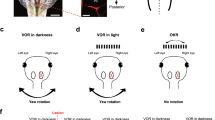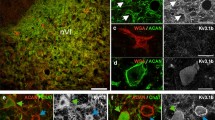Abstracts
We investigated how the physiological characteristics and synaptic activities of nonspiking giant interneurons (NGIs), which integrate sensory inputs in the brain and send synaptic outputs to oculomotor neurons innervating eyestalk muscles, changed after unilateral ablation of the statocyst in order to clarify neuronal mechanisms underlying the central compensation process in crayfish. The input resistance and membrane time constant in recovered animals that restored the original symmetrical eyestalk posture 2 weeks after operation were significantly greater than those immediately after operation on the operated side whereas in non-recovered animals only the membrane time constant showed a significant increase. On the intact side, both recovered and non-recovered animals showed no difference. The frequency of synaptic activity showed a complex pattern of change on both sides depending on the polarity of the synaptic potential. The synaptic activity returned to the bilaterally symmetrical level in recovered animals while bilateral asymmetry remained in non-recovered ones. These results suggest that the central compensation of eyestalk posture following unilateral impairment of the statocyst is subserved by not only changes in the physiological characteristics of the NGI membrane but also the activity of neuronal circuits presynaptic to NGIs.







Similar content being viewed by others
References
Budelmann BU (1977) Structure and function of the angular acceleration receptor systems in the statocysts of cephalopods. Symp Zool Soc Lond 38:309–324
Burrows M (1979) Synaptic potentials effect the release of transmiter from locust nonspiking interneurons. Science 204:81–83
Burrows M, Siegler MVS (1978) Graded synaptic transmission between local interneurones and motoneurones in the metathoracic ganglion of the locust. J Physiol 285:231–255
Darlington CL, Smith PF (2000) Molecular mechanisms of recovery from vestibular damage in mammals: recent advances. Prog Neurobiol 62:313–325
Davis WJ (1971) The integrative action of the nervous system in crustacean equilibrium reactions. In: Gordon SA, Cohen MJ (ed) Gravity and the organism. Chicago University Press, Chicago, pp 237–250
Deliagina TG (1997) Vestibular compensation in lampreys: impairment and recovery of equilibrium control during locomotion. J Exp Biol 200:1459–1471
Dieringer N (1995) Vestibular compensation: neural plasticity and its relations to functional recovery after labyrinthine lesions in frogs and other vertebrates. Prog Neurobiol 46:97–129
Dieringer N, Precht W (1977) Modification of synaptic input following unilateral labyrinthectomy. Nature Lond 296:431–433
Dieringer N, Precht W (1979a) Mechanisms of compensation for vestibular deficits in the frog. I. Modification of the excitatory commissural system. Exp Brain Res 36:311–328
Dieringer N, Precht W (1979b) Mechanisms of compensation for vestibular deficits in the frog. II. Modification of the inhibitory Pathways. Exp Brain Res 36:329–357
Finkel AS, Redman SJ (1985) Optimal voltage clamping with single microelectrode. In: Smith Jr TG, Lecar H Redman SJ, Gage PW (ed) Voltage and patch clamping with microelectrodes. American Physiological Society, Bethesda, pp 95–120
Furudate H, Okada Y, Yamaguchi T (1996) Responses of non-spiking giant interneurons to substrate tilt in the crayfish, with special reference to multisensory control in the compensatory eyestalk movement system. J Comp Physiol A 179:635–643
Galiana HL, Flohr H, Jones GM (1984) A reevaluation of intervestibular nuclear coupling: its role in vestibular compensation. J Neurophysiol 51:242–259
Hama N, Takahata M (2005) Modification of satatocyst input to local interneurons by behavioral condition in the crayfish. J Comp Physiol A 191:747–759
Hamann KF, Lannou J (1987) Dynamic characteristics of vestibular nuclear neurons responses to vestibular and optokinetic stimulation during vestibular compensation in the rat. Acta Otolaryngol Suppl 445:1–19
Highstein SM, Baker R (1985) Action of the efferent vestibular system on primary afferents in the toadfish, Opsanus tau. J Neurophysiol 54:370–384
Hisada M, Higuchi T (1973) Basic response pattern and classification of oculomotor nerve in the crayfish, Procambarus Clarkii. J Fac Sci Hokkaido Univ Ser VI Zool 18(4):481–494
Klinke R, Galley N (1974) Efferent innervation of vestibular and auditory receptors. Physiol Rev 54:316–357
Mellon DeF (1977) The anatomy and motor nerve distribution of the eye muscles in the crayfish. J Comp Physiol 121:349–366
Mellon DeF, Tufty RM, Lorton ED (1976) Analysis of spatial constancy of oculomotor neurons in the crayfish. Brain Res 109:587–954
Mellon DeF, Lorton ED (1977) Reflex actions of the functional divisions in the crayfish oculomotor system, J Comp Physiol A 121:367–380
Nakagawa H, Hisada M (1992) Local spiking interneurons controlling the equilibrium response in the crayfish Procambarus clarkii. J Comp Physiol A 170:291–302
Neil DM (1982) Compensatory eye movements. In: Sandeman DC, Atwood HL (ed) The biology of crustacea, vol 4. Academic, New York, pp 133–163
Newlands SD, Perachio AA (1990a) Compensation of horizontal canal related activity in the medial vestibular nucleus following unilateral labyrinth ablation in the decerebrate gerbil. I. Type I neurons. Exp Brain Res 82:359–372
Newlands SD, Perachio AA (1990b) Compensation of horizontal canal related activity in the medial vestibular nucleus following unilateral labyrinth ablation in the decerebrate gerbil. II. Type II neurons. Exp Brain Res 82:373–383
Okada Y, Yamaguchi T (1988) Nonspiking giant interneurons in the crayfish brain: morphological and physiological characteristics of the neurons postsynaptic to visual interneurons. J Comp Physiol A 162:705–714
Okada Y, Furudate H, Yamaguchi T (1994) Multimodal responses of the nonspiking giant interneurons in the brain of the crayfish Procambarus clarkii. J Comp Physiol A 174:411–419
Prentiss CW (1901) The otolith of decapode crustacea. Bull Mus Comp Zool Harv 36:167–254
Rall W (1969) Time constants and electronic length of membrane cylinders and neurons. Biophys J 9:1483–1508
Rall W (1981) Functional aspects of neuronal geometry. In: Roberts A, Bush BMH (ed) Neurones without impulses. Cambridge University Press, Cambridge, pp 223–254
Rall W, Burke RE, Holmes WR, Jack JJR, Redman SJ, Segev I (1992) Matching dendritic neuron models to experimental data. Physiol Rev (Suppl) 72:159–186
Ris L, De Waele C, Serafin M, Vidal PP, Godaux E (1995) Neuronal activity in the ipsilateral vestibular nucleus following unilateral labyrinthectomy in the alert guinea pig. J Neurophysiol 74:2087–2099
Ris L, Capron B, De Waele C, Vidal PP, Godaux E (1997) Dissociations between behavioural recovery and restoration of vestibular activity in the unilabyrinthectomized guinea pig. J Physiol (Lond) 500:509–522
Sakuraba T, Takahata M (1999) Effects of visual and leg proprioceptor inputs on recovery of eyestalk posture following unilateral statolith removal in the crayfish. Naturwissenschaften 86:346–349
Sakuraba T, Takahata M (2000) Motor pattern changes during central compensation of eyestalk posture after unilateral statolith removal in crayfish. Zool Sci 17:19–26
Schaefer KP, Meyer DL, Wilhelms G (1979) Somatosensory and cerebellar influences on compensation of labyrinthine lesions. Prog Brain Res 50:591–598
Siegler MVS (1981) Postural changes alter synaptic interactions between nonspiking interneurons and motor neurons in the locust. J Neurophysiol 46:310–323
Schöne H (1954) Statozystenfunktion und statische Lageorientierungbei dekapoden Krebsen. Z Vergl Physiol 36:241–260
Schöne H (1971) Gravity receptors and gravity orientation in crustacea: In: Gordon SA, Cohen MJ (eds) Gravity and the Organism. Chicago University Press, Chicago, pp 223–236
Silvey GE, Sandeman DC (1976) Integration between statocyst sensory neurons and oculomotor neurons in the crab Scylla serrata III. The sensory to motor synapse. J Comp Physiol 108:53–65
Smith PF, Darlington CL, Curthoys IS (1986) The effect of visual deprivation on vestibular compensation in the guinea pig. Brain Res 364:195–198
Smith PF, Curthoys IS (1988a) Neuronal activity in the contralateral medial vestibular nucleus of the guinea pig following unilateral labyrinthectomy. Brain Res 444:295–307
Smith PF, Curthoys IS (1988b) Neuronal activity in the ipsilateral medial vestibular nucleus of the guinea pig following unilateral labyrinthectomy. Brain Res 444:308–319
Smith PF, Curthoys IS (1989) Mechanisms of recovery from unilateral labyrinthectomy. Brain Res Revs 14:155–180
Stewart WW (1978) Functional connection between cells as revealed by dye-coupling with a highly fluorescent naphthalimide tracer. Cell 14:741–759
Sugawara K, Hisada M, Higuchi T (1971) Eyestalk musculature of the crayfish, Procambarus Clarkii. J Fac Sci Hokkaido Univ Ser VI Zool 18(1):45–50
Van Harreveld A (1936) A physiological solutions for fresh water crustaceans. Proc Soc Exp Biol Med 34:428–432
Vibert N, Bantikyan A, Babalian A, Serafin M, Muhlethaler M, Vidal PP (1999). Post-lesional plasticity in the central nervous system of the guinea pig: a `top-down’ adaptation process ? Neurosci 94:1–5
Wiersma CAG, Yamaguchi T (1967) Integration of visual stimuli by the crayfish central nervous system. J Exp Biol 47:409–431
Williamson R (1989) Secondary hair cells and afferent neurones of the squid statocyst receive both inhibitory and excitatory efferent inputs. J Comp Physiol 165:847–860
Wilson WA, Goldner MM (1975) Voltage clamping with a single microelectrode. J Neurobiol 6:411–422
Yamaguchi T, Okada Y (1990) Giant brain neurons of the crayfish: their functional roles in the compensatory oculomotor system. In: Wiese K, Krenz WD, Tautz J, Reichert H, Mulloney B (ed) Frontiers in crustacean neurobiology. Birkhäuser, Basel, pp 193–199
Yoshino M, Kondoh Y, Hisada M (1983) Projection of statocyst sensory neurons associated with crescent hairs in the crayfish Procambarus Clarkii Girard. Cell Tissue Res 230:37–48
Acknowledgments
We thank Dr. N. Hama for helpful comments and suggestions. We also gratefully acknowledge anonymous reviewers for their constructive criticisms and suggestions. This work was supported in part by a Grant-in-Aid for Scientific Research (No.17370024) from the Ministry of Education, Culture, Sports, Science and Technology of Japan.
Author information
Authors and Affiliations
Corresponding author
Rights and permissions
About this article
Cite this article
Fujisawa, K., Takahata, M. Physiological changes of premotor nonspiking interneurons in the central compensation of eyestalk posture following unilateral sensory ablation in crayfish. J Comp Physiol A 193, 127–140 (2007). https://doi.org/10.1007/s00359-006-0175-9
Received:
Revised:
Accepted:
Published:
Issue Date:
DOI: https://doi.org/10.1007/s00359-006-0175-9




